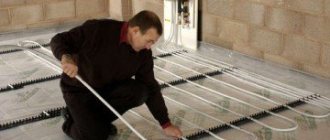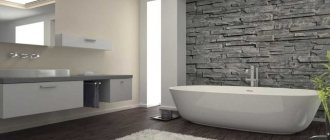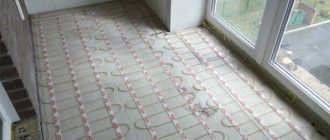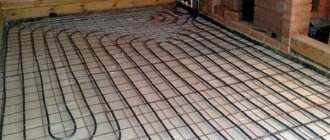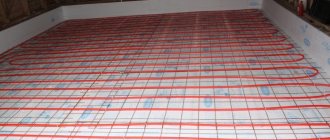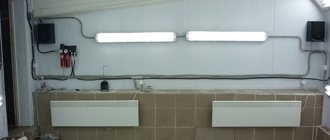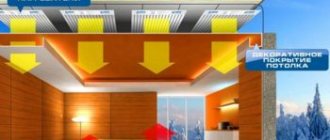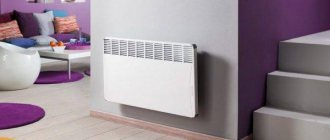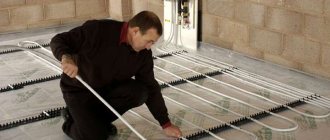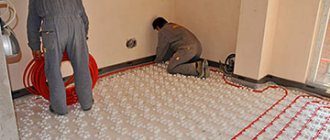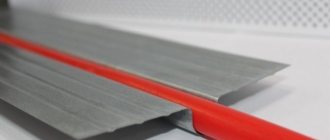Some subtleties of heating a garage space
The garage is a non-residential premises, so the optimal temperature here is much lower. In order not to cause harm to the car, it is enough to maintain 150C. If a person is dressed in appropriate clothing, then he will feel quite comfortable under such conditions. In addition, strong heating will require a large amount of energy, which is unprofitable from an economic point of view.
The thermal insulation of the garage also deserves attention, because in an uninsulated room with thin walls and a large number of cracks it will be very difficult to maintain a comfortable temperature. To insulate walls, you can use any insulation material, for example, penofol. You shouldn’t skimp on thermal insulation; this expense item quickly pays for itself by saving energy resources.
Unlike a living space, increased loads are placed on the floor surface in a garage. This may include the impact of machine wheels and unexpected impacts from tools and parts. Therefore, the screed above the heating elements should be quite high, the optimal value is 4-8 cm. This thickness makes it unprofitable to use infrared heating film, which under these conditions will produce a small amount of heat.
Most often, they install electrical systems or water heated floors in the garage with their own hands. In the first case, a heating cable is used as a heating element, in the second - steel tubes. Each type of heating is characterized by its own advantages and disadvantages, which should be discussed in more detail.
Kinds
To date, two types of heated floors have been developed, differing in design, installation technology, list of materials used and technical characteristics.
Water
Water heated floors are distinguished by safety and comfort.
It is a circuit with a coolant connected to the centralized heating system of the building. In autonomous systems, the heat source is a boiler: gas, electric or solid fuel. Several methods have been developed for constructing a water TP, but they all work on the same principle:
- The coolant heats the pipes;
- Heat is transferred to the screed and floor covering, and then to the air in the heated room.
There are two types of water TP:
- concrete;
- lightweight.
In the first option, the pipes are located in a layer of concrete screed. In the second, they are laid in polystyrene foam boards with special recesses or in boxes made of wooden boards. But these structures are also filled with a layer of concrete screed.
Electric
An electric heated floor is easier to install, but much more expensive in terms of finances.
An electric TP does not have the disadvantages of a water heater: labor-intensive and time-consuming installation. It has only one “minus” - the cost of paying for electricity. The main advantage is that there is no risk of water leaks and flooding of neighbors below.
The electric TP is a flexible mat on which the heating circuit is mounted; there are outputs for connection to the control unit and similar system elements. Two types of this equipment have been developed:
- Cable. The main element of this design is an electrical cable, which can be single-core, double-core and self-regulating.
- Infrared. The heat source here is a flexible or carbon rod emitter that generates waves in the infrared range.
Temperature
Having laid out the heat source on the floor and connected it correctly, we can assume that the system is ready. But to create comfort, garage floor heating must be adjustable.
Devices have been developed for the water and electrical systems that allow you to set and maintain the selected temperature
For an electric floor, this is a thermostat with a sensor connected to it. The sensor is located in a special tube in the floor and records temperature changes. It sends signals to the thermostat controller. The controller processes the signal and changes the current strength in the wires. At the same time, very often the device contains a controller that allows you not only to maintain the set temperature, but also to work on time, which is very convenient in terms of saving energy.
The temperature of a water heated floor can be adjusted in several ways. The first method involves controlling the temperature of the coolant entering the system, and the second involves completely stopping its supply when the required value is reached.
Based on their operating principle, thermostats are divided into the following categories:
- Manual. They are an ordinary valve. By opening or closing it slightly, they change the pressure in the system, and therefore the speed of water circulation.
- Thermostatic. The operation is based on the principle of operation of valves, but at the same time it is completely automatic. The system contains a sensor that gives a signal to supply water according to its program. Thermostatic devices are capable of controlling the temperature in several circuits simultaneously, turning heating on or off depending on the time of day.
- Temperature relay. This device is located on the return pipe manifold. It is powered in such a way that the operation of the circulation pump is controlled through a thermal relay. Having set a certain temperature on it, the pump will turn off when it reaches it, and as soon as it drops, the thermal relay will start it again, ensuring the flow of hot coolant into the circuit.
The manifold for underfloor heating is one of the main components of the heating system
Electric floor heating system
In this case, when electric current passes through a flexible conductor, heat is released. The conductor heats the screed, which in turn transfers heat into the room.
Electric heated floors are easy to install and highly reliable. However, energy costs for this type of heating are quite high, especially in cold winter.
To reduce costs, it is important to make high-quality thermal insulation of walls and ceilings. The optimal insulation thickness for these garage surfaces should be more than 6 cm. Thermal insulation of the floor should also be given attention.
When drawing up a project for an electric heated floor in a garage, it is important to take into account the load that will be placed on the garage's electrical network. The calculations are based on the amount of energy required to heat 1 m2 of room, which is 120-140 W. If this value is multiplied by the area of the garage, the required amount of energy will be obtained. When installing a heated floor, it is important to be sure that the wiring in the garage can withstand such a load for a long time.
Rules for preparing the base
Most often, there is soil under the garage floor, so before making heated floors from water heating or electricity, you should pay attention to thermal insulation. The fact is that improper insulation can lead to significant heat losses, up to 30%, which are associated with warming up the soil.
The insulation process is as follows:
- The soil is carefully leveled and compacted.
- A rough concrete screed is poured on top of it. It is important to control this stage so that the surface is as smooth as possible without sudden changes in height.
- The screed is left to harden, after which the heat-insulating material is laid.
Floor insulation with plywood
As an option, car enthusiasts can insulate the concrete floor in the garage with plywood. The big advantage is that the material can also be used as a finishing material. There are several brands of plywood, the most moisture-resistant are FSF, but they are recommended for use exclusively in non-residential premises with high humidity.
This is due to the use of too toxic glue that glues the plywood layers together. A safer option would be to use FC grade material.
The entire insulation process begins with cleaning the concrete from dirt and dust. Then an additional heat insulator - polyethylene foam - is laid out on the surface, protecting the plywood from concrete dampness. Beams are laid on top, acting as a frame and a subfloor.
Next, the plywood covering is laid. If this is the last layer, then you should cover it with varnish or paint.
Plywood should not be used in very damp rooms. Humidity is checked using a sheet of polyethylene, it is laid out on the floor and pressed firmly. Then they leave it for a couple of days and then check: if there are drops, it means the humidity is high, perspiration indicates medium humidity, dry polyethylene means low humidity.
Insulation of electric heated floors
The best option for do-it-yourself insulation of a heated floor in a garage is considered to be penoplex or polystyrene. For high-quality thermal insulation, the material must have a thickness of 3-8 cm, which is determined by the severity of the climate of the area. For example, 3 cm thick insulation can be used in regions where the air temperature does not drop below -150C. If the region experiences severe winters, it is better to use material up to 8 cm thick.
When thermally insulating a floor with a heating element in the form of a cable, a special mounting tape is laid on top of the insulation, which secures the cable turns. The recommended distance between strips of tape is 0.5 meters. The tape is fastened with dowels to the rough screed. If mats are used as a heater, then mounting tape is not required, so you can immediately begin installation work.
Advantages and disadvantages of various materials used for floor insulation
Various materials that can be used to insulate a garage floor have their own inherent advantages and disadvantages, which determine the possibility and economic feasibility of their use.
Let's summarize the advantages and disadvantages of building materials in a table.
| dignity | flaws |
| Expanded clay | |
|
|
| Penoplex | |
|
|
| Mineral wool | |
|
|
Laying the heating element
Installation of a heated floor with a heating cable is carried out according to the following scheme:
- The wire is laid in turns, maintaining a distance of 0.3 meters between them.
- Each turn is fixed with special antennae on the mounting tape.
- During installation, it is necessary to ensure that the turns are parallel to each other.
- It is not recommended to bend the wires at an angle less than 90 degrees or apply too much tension.
- The heating element is placed in places where there are no pieces of furniture. In other words, do not place wires under shelving or a workbench so as not to interfere with the warm air flow.
- When performing installation work, it is not recommended to step on the cable so as not to damage the insulation.
- Wires should only be used as solid wires, without twisting or soldering. Otherwise, the service life of such a floor, as well as its reliability, are significantly reduced. If a single section of the cable is damaged, the entire circuit must be replaced.
Installation of a heated floor in a garage with heating mats is simpler, since it consists of coils of cable laid according to certain rules and secured to a reinforcing mesh. The installation process involves laying heating mats on the floor. After this, they immediately begin connecting the system.
After laying the heating elements, proceed to install the temperature sensor; to do this, perform the following steps:
- Stepping back from the wall about 0.5 meters, a small depression is made in the heat-insulating layer.
- A corrugated pipe with a diameter of 2 cm is placed in it. Thanks to the pipe, you can replace the sensor even after pouring the screed.
- A temperature sensor is placed in this pipe.
Next, a thermostat is mounted at a height of 0.3 meters from the floor surface.
Cable floor installation
As mentioned above, cable floors run on electricity, and since the tariffs are quite high, the costs are significant.
Calculation
The installation of cable electric heating, as well as the installation of an infrared system, should begin with calculating the power; there is a single formula for this.
You can familiarize yourself with the rules for calculating power in the section “Installation of infrared flooring”.
Drawing up a diagram
Before installing any heated floor, it is necessary to prepare a diagram showing the cable laying areas and the location of the regulator.
According to SNiP, if the area of the heating elements exceeds 40 m2, then damper gaps must be made. The rules for placing the mat are similar to laying the film.
Required tools and materials
Before proceeding directly to installing the heating system, you need to purchase the material and prepare the tools that you will need if you are going to do the installation yourself.
First you need to choose the type of heating:
- Resistive cable - there is one or two wires. It produces heat energy, its volume depends on the cross-section of the wire.
- The heating mat is a flexible sheet with a resistive wire already fixed on it. It is comfortable and easy to install.
Any model is suitable for installation in a garage.
The remaining materials and tools for constructing cable heating are the same as for installing an infrared system.
Preparing the base
Preparing a rough base in the garage for laying cables is no different from these works; when installing any heated floor - leveling and cleaning the surface.
Thermal insulation
The detailed process of hydro and thermal insulation is described in the section on infrared floors; it is the same for all electrical systems. That is, polyethylene is laid, damper tape is installed, insulation and fittings are installed.
Laying heating elements
Installation of the heating cable is carried out according to the developed scheme (“snake” or “snail”), for this purpose markings are applied to the insulation. According to these marks, the wire is laid in turns, the standard distance between which is 0.3 meters .
The circuits should be placed parallel, the cable should be bent at an angle of less than 90 degrees or it should be excessively stretched. The wire must be solid, without twisting, as this will affect the quality of work and service life. The cable is fixed to the mesh with clips or antennae on the mounting tape, which is attached to the insulation.
When laying heating mats, the work of installing a warm electric floor in the garage is greatly simplified, because the wire is already fixed to a special mesh. You just need to roll out the mats on the surface and fix them.
Connection
A mounting box is attached to the planned location, into which the thermostat is installed. A power and grounding cable is supplied to it.
To install a temperature sensor in the insulation at a distance of 0.5 meters from the wall, it is necessary to make a recess. A corrugated pipe with a sensor placed inside is placed in it. The wire from the sensor is also connected to the regulator.
After connecting, the device must be checked for functionality. The heated floor must be plugged into a separate outlet.
Filling the screed
The solution for pouring the cable floor and the process itself is similar to concreting an infrared system. A concrete screed can be used as a finishing surface in a garage, but it is permissible to lay tiles on top if desired.
Connecting the "warm floor" system
It is recommended to connect an electric floor heating system only using copper wires, the cross-section of which is determined by the final load.
A thermostat is installed on the wall and a heating element and temperature sensor are connected to it. The work is carried out in strict accordance with the instructions that the manufacturer encloses with the regulator.
Testing an electric heated floor by applying voltage to the system is strictly prohibited. To ensure the integrity of the insulation and correct connection, before connecting to the thermostat, measure the resistance of the heating element and compare the result with the recommended value. The difference should not exceed 10%.
To connect an electric heated floor to the network, you must use your own residual current switch.
Voltage is supplied to the “warm floor” system only after the screed has completely hardened.
As a finishing option, it is recommended to use a special screed for heated floors, which is characterized by the best thermal conductivity coefficient. In addition, the use of ordinary concrete screed or self-leveling floors is allowed. The height of the screed is determined by the weight of the car and the planned work in the garage. The optimal height is 3-5 cm above the heating element. Taking into account the thickness of the thermal insulation material used is about 5 cm, the minimum height of the screed should be 5 cm. The optimal thickness of the screed is selected after assessing the intensity of the load on the surface of the heated floor.
When deciding how to make a heated water floor in a garage, you should remember that you can only turn on the heated floor system into the power supply after 28 days. During this time, the screed above the heating element will completely harden.
Concrete screed can act as a finishing coating; it is also possible to install a heated floor under the tiles in the garage. In any case, the heating properties of the floor will not change.
Insulated floor
Let's start from this position, because the insulation is laid at the stage of forming the floor base. First of all, you need to choose a thermal insulation material. There is little variety here, because the garage floor is subject to quite serious loads. Therefore, for thermal insulation, either bulk materials or high-density slab materials will be required.
The first include:
- expanded clay;
- perlite;
- vermiculite and so on.
The second ones are polystyrene foam boards. With slab insulation, not everything is so simple. Here you will need material whose density should be above 150 kg/m³.
Insulation technology
Before insulating the floor in the garage, you need to choose a thermal insulation material. Optimally - bulk. It's easier to work with him. The only thing you need to think about is the thickness of the layer being poured. If it is expanded clay, then at least 20 cm. If perlite or vermiculite, then 10-15 cm after compaction.
Sequence of operations:
- The area between the foundation elements is cleared of debris and vegetation and leveled.
- Sand is backfilled 30 cm thick. This size is not chosen in vain, because sand can only pass moisture up to 30 cm. In fact, the sand layer acts as a waterproofing layer.
- A layer of crushed stone 10-12 cm thick is poured.
- A waterproofing base is laid from roofing material folded in half or from a polymer film. The main thing is to make the layout so that the film covers the side planes of the foundation.
- Thermal insulation material is poured in and leveled horizontally.
- Another layer of waterproofing.
- Installation of a reinforcing frame made of steel reinforcement, which is made in the form of a lattice with cells of 20x20 cm. Please note that the lattice is laid on supplies. The goal is for the reinforced frame to be inside the concrete solution. Stone, brick, metal profiles or special iron or plastic structures, which are sold in stores, are used as stands.
- A concrete solution is poured, which forms the floor in the garage. Its thickness is at least 10 cm.
Floor insulation with expanded clay
Some subtleties of technology. Do you need a reinforcing frame? Not always. If a garage is being built for one car, then the thickness of the concrete screed can be increased to 20 cm. And this will guarantee that the floor will not crack or bend under the weight of the car.
When pouring a concrete floor on the ground, it is recommended to leave a small gap between the screed and the foundation surfaces. It is called damper or compensation. Therefore, before concreting the floor, it is necessary to lay a damper tape along the side planes of the foundation structure.
Insulation with polystyrene foam boards
Is it worth using this material at all? If you choose the required density, taking into account the thickness - at least 10 cm - then this is a good option. Expanded polystyrene boards today are produced with a tongue-and-groove joint, so that the thermal insulation surface will be free of gaps and cracks.
Sequence of processes:
- A cushion of sand and crushed stone is poured.
- A thin screed 5 cm thick is poured. PP slabs are laid only on a durable and dense surface.
- Waterproofing is being installed.
- Insulation boards are installed, which can be easily cut to the required dimensions using a regular saw or knife.
- Second layer of waterproofing.
- Pouring concrete mortar either over a reinforcing frame or without it.
Floor insulation with polystyrene foam boards
Water-based "warm floor" system in the garage
A water heated floor in a garage is considered a more economical heating option, but for its operation it requires installing a boiler or connecting to the existing heating system in the house. It is this fact that makes the installation process more complex and costly in material terms.
However, do-it-yourself heated water floors are considered beneficial, since they do not require large energy costs compared to electric heated floors.
It is recommended to install a boiler if it is impossible to use other options, which is explained by large financial investments.
When drawing up a project, you should pay attention to the connection diagram of the heated floor to the general heating circuit and correctly determine the location of the distribution unit. Also, in the process of solving the problem of how to make a heated floor in a garage, it is necessary to calculate the length of the pipes in accordance with the area of the garage and select a pump of the appropriate power for the perfect operation of the system.
When connecting to a radiator heating system, be aware that the operating medium temperature in the circuit is too high. To reduce this parameter, install a mixing unit. Here the heated coolant will mix with the cooled liquid that has passed through the entire system. When using a separate boiler for the “warm floor” system, you can adjust the temperature values directly on the boiler.
The distribution unit includes a mixing unit, a collector group and a pump for forced circulation of the coolant. All this is placed in a distribution cabinet, which can be purchased at any specialized store. In this case, you can choose a cabinet of a certain capacity, assembled and tested at the manufacturer. The selected cabinet is installed in the most suitable location and connected to the general heating system. After this, the warm floor is connected to the collector group.
Laying water heated floors
There are several ways to install a water TP. In order to minimize heat loss, when building a garage it is advisable to build a USP (insulated Swedish stove) . The pie is as follows:
- 50-10 cm of compacted sand;
- 10-15 cm of crushed stone or gravel;
- insulation (foam plastic 5-10 cm thick, depending on the climatic conditions of the region);
- waterproofing (polyethylene film, roofing felt, special membranes);
- metal mesh made of reinforcement;
- concrete.
But heated water floors can be laid on any existing surfaces. Work on its device begins with design: calculation of thermal power and circuit length, selection of materials and control automation.
Calculation
If you want to make the calculation yourself, use average indicators
The fundamental calculation factor is the pipe laying scheme. The most important indicators are the pitch between the loops and their length. The smaller the distance between adjacent pipes, the higher the thermal efficiency of the transformer substation.
Reference! If the heated floor in the garage will be the main source of heat, the optimal step between the hinges is 100 mm, if the backup one is 300 mm. If in the first case the distance is reduced, there is a high risk of pipe fracture. When the pitch increases to more than 300 mm, the so-called “zebra effect” is inevitable, consisting in alternating stripes of warm and cold space on the floor surface.
To calculate water TP, special calculators and formulas are used. In order not to involve specialists and not to burden your head with information about the specifics of performing thermal calculations, you can use the average indicators on the basis of which warm water floors were installed in many garages. Moreover, the owners are satisfied with the results obtained.
- The optimal cross-section of a metal-plastic pipe is 16 mm.
- The recommended circuit length for heating a garage with an area of 60 m2 is 70-80 m. The specified pipe length in one circuit should not be exceeded.
- At walls and gates, loops are laid in smaller increments than in the middle of the room.
- The supply pipeline is laid closer to the outer walls.
- The power of the circulation pump is at least 2 l/s.
Required tools and materials
When choosing materials, you can focus on standard water floor kits with automatic temperature control, offered by manufacturers for unheated lower rooms with an area of 60-80 m2.
With a spiral laying pattern with a pitch between pipes of 15-20 cm, a coolant temperature of 30°C and a screed thickness of 3 cm (7 cm is required for a garage), the estimated floor surface temperature is 24-26°C.
| Materials | Quantity |
| Metal-plastic pipe Valtec | 400 m |
| Plasticizer "Silar" | 80 l |
| Energoflex tape | 60 m |
| Heat-insulating mats "Energoflex Super TP - 25/1.0-5" | 60-80 m2 |
| Three-way mixing valve MIX 03 ¾” | 1 |
| Circulation pump | 1 |
| Regulating thermostat EM 548 | 1 |
| Fittings for installation of plastic pipes | |
| Automatic air vent VT 502 1/2” | 2 |
| Servomotor for mixing valve NR 230 | 1 |
Determined with the pipe laying diagram. Two options are optimal:
Single coil circuit
- "single coil";
Spiral scheme - spiral
Preparatory work
Old floor - away!
Installation of the TP system begins with leveling the surface:
- If there is a floor covering, it is opened using a hammer drill and other necessary tools.
- Thoroughly clean the resulting surface from construction debris and dust.
- Take measurements with a laser level and make sure that there are no height differences of more than 5 mm. If necessary, pour a layer of self-leveling screed.
- Damper tape is laid along the walls of the room. It should protrude above the calculated level of the finished TP by 20-30 mm.
- Lay a heat insulator. The optimal choice is “Penoplex” with a thickness of 5 mm. They also use polystyrene foam with a density of at least 25 kg/m3 and 3 cm thick EPS with markings for laying water transformer pipes.
- Lay a reinforced mesh with a mesh size of 10x10 cm.
On a note! Experts recommend laying metal mesh not under the pipes, but above them. In the first case, the mesh turns out to be useless and serves as an ordinary substrate for the loops of the circuit. In the second option, it reinforces the screed poured over the pipes. Instead of metal, you can use plastic.
Step-by-step installation instructions
During the process of installing a warm water floor, assistance will often be required, so we advise you to start working with a partner
Step 1. According to the previously drawn up diagram, the location of the pipes is marked on the heat-insulating material.
Step 2. Lay the pipes, bending them and focusing on the markings. Fix with harpoon staples every 30-40 cm, and on bends - every 10-15 cm.
At this stage it is advisable to have an assistant . It is also recommended to buy a special device for unwinding pipes, or make it yourself from scrap materials. Laying the loops begins from the zones most distant from the collector:
- remove 10-15 m of pipe from the coil;
- install a heat-insulating tube and a fitting for connection to the manifold at one end;
- form the contour of the TP;
- return the second end of the pipe to the manifold and install the appropriate fitting.
Important! When unwinding, the coil with the pipe must be twisted. If you remove it from a stationary bay, unnecessary kinks and bends will appear.
Step 3. Install the manifold cabinet.
Step 4. Corrugation is put on the pipes leading to the inlet and outlet of the collector.
Step 5. Connect the automation.
Step 6. Conduct hydraulic tests and pressure testing of the system at a pressure of 1.5 of the working pressure, but not less than 0.3 MPa.
Step 7. Prepare a cement-sand mortar and pour the screed along the beacons.
Base for water heated floor
In general, the base for all types of “warm floor” systems is prepared according to the same scheme. In the case of a heated floor in a garage, it should be taken into account that the height differences should not exceed half the diameter of the pipe. In this case, it is possible to prevent the formation of air pockets that impede the normal circulation of the coolant and the heated floor heating will work as it should.
A distinctive feature of the water heated floor system is the presence of special thermal insulation, which makes pipe laying easier. The top layer of insulation is equipped with small protrusions arranged in a checkerboard pattern; water circuit tubes are placed in them. It is worth noting that the price of this option will be higher.
When using conventional insulation with a height of 3-8 cm, the pipes are distributed on the mounting grid.
Pipe laying
Water heated floor pipes are most often laid using the “snake” method with parallel distribution of turns over the entire area of the room. The pipes are secured with clamps or wire.
If the garage area is large, pipes are laid using the “spiral” method. In this case, the area is heated more evenly, although installation is considered more labor-intensive.
When laying pipes using any method, it is prohibited to bend the pipes at an angle of less than 90 degrees, so as not to damage the heating element. For the same reason, you should not step on pipes and damage them. If any section is damaged, the entire circulation circuit must be replaced.
Safety precautions
Operation of heated floors, all installation work must be carried out strictly in accordance with the instructions from the manufacturers.
There are several risks when working with them:
- leakage – relevant for water and antifreeze floors. In the first case, the quality of heating is simply impaired and dampness increases. Leaks of ethylene glycol antifreeze can cause poisoning. This substance creates toxic fumes that cause various diseases. Propylene glycol is safer. Antifreeze is also fluid and leaks in the most unexpected places;
- short circuit, overheating - relevant for the electrical circuit. This type of floor does not like carpets and other coverings, as they retain heat and lead to overheating of the system. For this reason, the wheels should not rest on the cable.
Testing a water heated floor system
To identify problem areas in the water circuit, it is necessary to test the system. To do this, a coolant is supplied to it, and a pressure is set on the pump that exceeds the operating values by 1.5-2 times. In most cases, this parameter is 5 bar. The test lasts about a day at a stable pressure, during which time no wet spots should appear on the floor. By the end of the test period, the pressure should be at operating values.
The maximum temperature value is set on the boiler or mixing unit. After a certain time, all areas of the underfloor heating system should warm up. After about a day, in a normally functioning circuit, the pressure and temperature should remain unchanged. Only under these conditions can you start pouring the screed.
Pouring finishing screed
You can fill the finishing screed only if there are no defects in the system. Before direct filling, the circuit is filled with coolant, but it is not heated. Experts recommend maintaining the temperature in the circuit at the same level as the room temperature. Filling the screed when the liquid in the system is heated is a violation of safety regulations.
Ready-made compounds for underfloor heating screed can most often be used at temperatures above 0 degrees. Therefore, you should purchase a screed that is optimally suited for certain conditions. This can be found on the packaging from the manufacturer. In addition, it is important to remember that you can increase the temperature in the room in any way, with the exception of using a “warm floor” system.
The height of the screed is selected for each case individually, although its thickness may be the same for an electric heated floor or a water circuit. The system can only be turned on after the screed has completely hardened.
